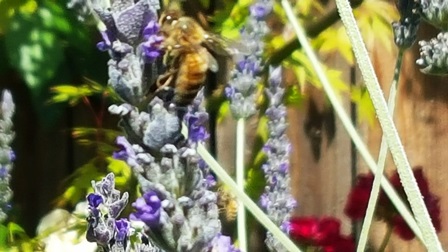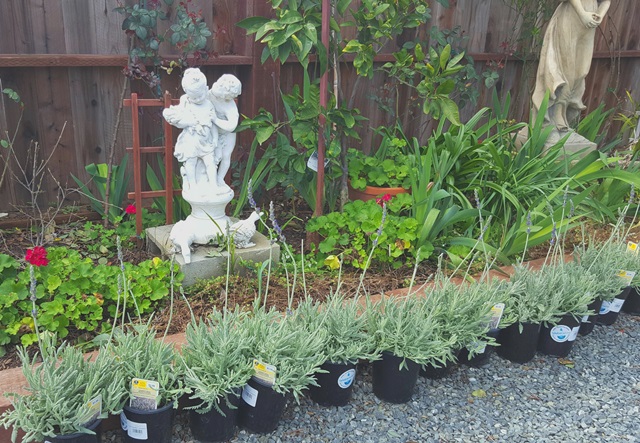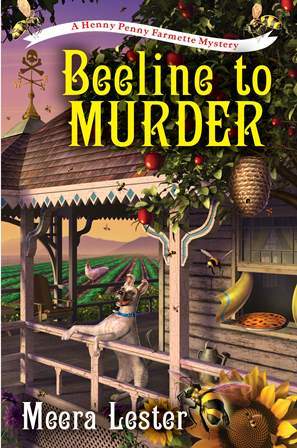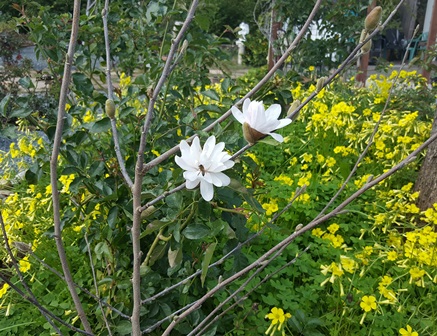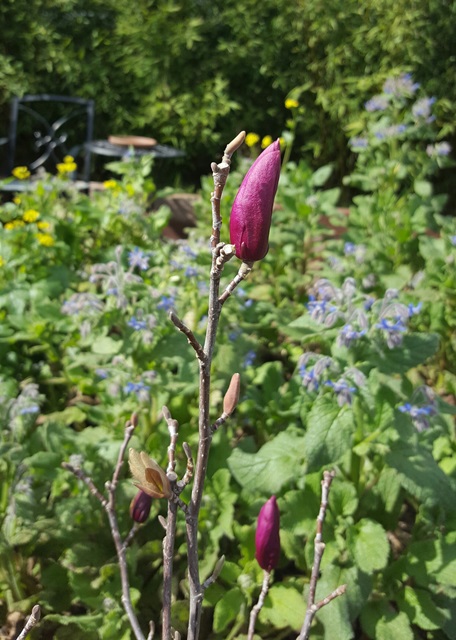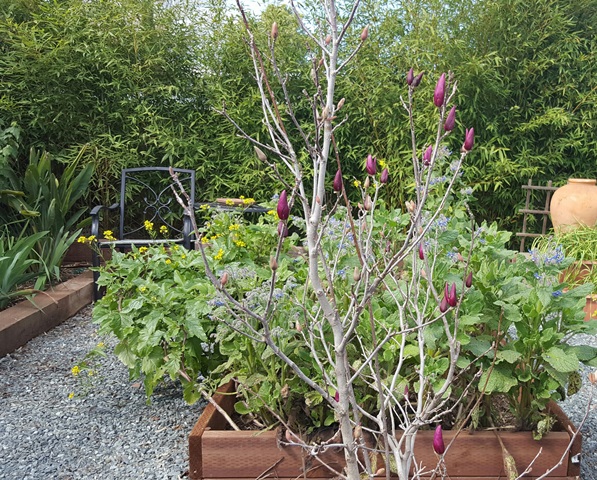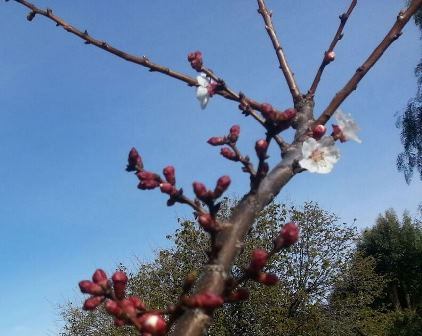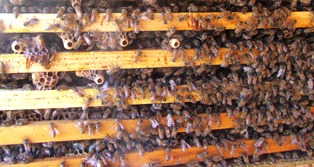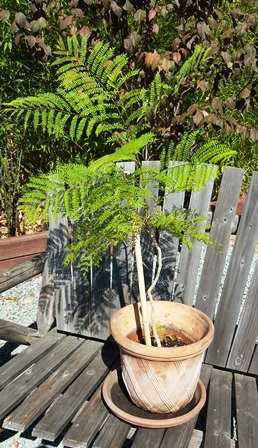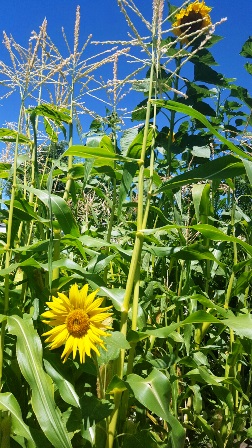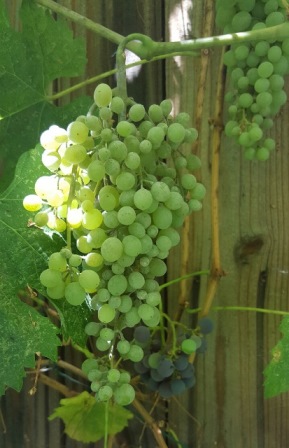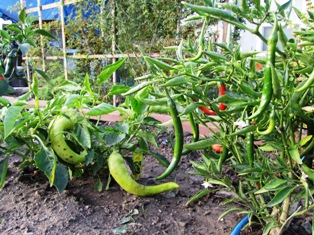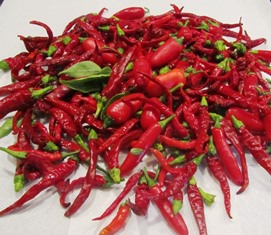Archive for the 'Plants and Trees' Category
French Lavender–A Favorite of Pollinators
It’s bare-root season, a special time of the year for me. I like to visit local nurseries and check out the new offerings of heirloom roses, fruit trees, berries, herbs, and flowers. No matter which nursery I visit, I always seem to spot the lavender first.
After we moved to the Henny Penny Farmette, we put in lots of French lavender. But after a few years, the stalks have grown old and woody.
Recently, on a visit to a nearby nursery, we purchased twenty one-gallon plants of French Lavender, an upright perennial that we’ve discovered blooms almost all year long in our Bay Area climate.
Now, they are hardening off in my garden until I get around to planting them.
The word “dentata” means toothed and a closer examination of the foliage reveals fringed indentations.
This aromatic, shrub has been around for centuries. Valued for its ornamental and medicinal properties, it also is used for soil erosion control. Once established, the lavender is drought tolerant.
Many gardeners love this lavender for its gray-green leaves. When other flowering plants in the garden have finished their blooming cycle, this lavender keeps producing tall spikes of bright purple florets.
Not as brilliant in color as the English or Spanish lavender, the French lavender is lovely grouped together in a single area where its flower stalks can sway in the wind. Our honeybees and other pollinators love it.
* * *
If you are a fan of cozy mysteries and love farmette topics like gardening of heirloom vegetables, herbs, and fruits as well as keeping chickens and bees, check out my Henny Penny Farmette series of cozy mysteries from Kensington Publishing.
Besides a cozy mystery to solve, these books mix in delicious recipes, farming and gardening tips, facts about keeping bees and chickens, and morsels of farm wisdom.
- COMING SOON– Sept. 2017, the third novel in the Henny Penny Farmette series
The Star of Spring–the Mighty Magnolia
My spouse hails from the Caribbean where a variety of magnolias grow, but many in the islands are under threat from deforestation and small distributions. He’s wanted to plant a magnolia tree since we moved to the farmette. Recently, on a rainy evening, we ventured out to our local nursery and purchased a Royal Star and a Jane magnolia for the large entrance area at the front of our property.
Often, it is the m. grandiflora that comes to mind when someone mentions a magnolia tree. It’s a big evergreen tree with glossy leaves, large tulip-shaped white flowers, and dense canopy. This tree blooms summer and fall, while other types of magnolias bloom before their leaves show in the spring.
Magnolias offer gardeners many options–evergreen or deciduous types, wide-range of flower colors, slow or fast-growing trees, and small to large and stately specimens. Named for the French botanist Pierre Magnol (1638-1715), the genus includes about 100 species.
Magnolia blossoms are fragrant and attract various pollinators. While some magnolias grow well in containers for a few years or as espaliers, the larger, showy trees are often planted along city streets and in parks.
Until we have settled on the exact planting site for each of our magnolias, they will remain in their pots. Where to plant them is an important decision since magnolias do not like to be moved once established. As a general rule, they need rich well-drained soil and benefit when the soil has plenty of organic matter like leaf mold, peat moss, and ground bark mixed in at planting time.
Magnolia trees must be planted no lower than their original soil level (where the trunk begins in the planting pot). Because they need plenty of water until established, it’s a good idea to dig a watering basin around them. Young trees must be staked to protect against wind damage.
We chose the Royal Star magnolia (magnolia stellata) because it can hold abundant and spectacular white (or pink) perfumed blossoms throughout spring into summer. Reaching a height of 15 feet with a canopy spread to 10 feet, this beauty looks magnificent against a garden fence. Such a barrier will help protect it against the wind and also create a foil for the blossoms. Come autumn, songbirds will feast on the high-fat content of the star magnolia’s capsules of orange seeds.
The Jane magnolia is one in a Little Girl series of hybrid magnolias that include: Ann, Betty, Judy, Pinkie, Randy, Ricki, and Susan. These magnolias were developed in the mid-1950s at the National Arboretum by Francis DeVos and William Kosar. Jane has large-cup flowers opening reddish-purple with white interiors. Shortly after the blossoms show, the leaves emerge as a coppery-red before turning green.
At the moment, our Jane magnolia, with its roots balled and wrapped in burlap and looking like a shrubby bush, is covered with an abundance of buds as yet unfurled. The buds hold the promise of the fragrant purple blossoms in a couple of weeks. This slow-growing magnolia will reach a height of 10 feet with a 10-foot canopy spread. The plant will be a sure show-stopper in any Northern California garden, especially in spring.
* * *
If you enjoy reading about gardening or other farm topics like keeping bees and chickens, check out my cozy mysteries–A BEELINE TO MURDER, THE MURDER OF A QUEEN BEE, and (coming Sept. 2017) A HIVE OF HOMICIDES (in the Henny Penny Farmette series from Kensington Publishing).
My farm-based novels feature delicious recipes, farming tips, chicken and beekeeping tips, sayings and, of course, a charming cozy mystery. The books are available through online retailers such as Amazon, Barnes & Noble, Target, BAM, Kobo Books, and Walmart as well as from traditional bookstores everywhere.
See, http://tinyurl.com/hxy3s8q
See, http://tinyurl.com/h4kou4g
See, http://tinyurl.com/zsxqmm3
How to Attract Hummingbirds to Your Garden
Here on the Henny Penny Farmette, we love watching the spectacular aerial maneuvers of male hummingbirds attempting to attract the interest of a nearby female. These gorgeous feathered flirts know how to bedazzle a potential mate with spectacular maneuvers that show off the intense coloring of their iridescent feathers.
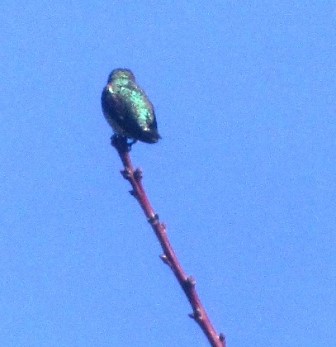
A hummer’s iridescent feathers shimmer as it perches in sunlight at the end of an apricot tree branch
Depending on the species, these tiny birds can flutter their wings in a figure eight pattern (they don’t flap them) from 12 to 80 times per second. All that fluttering requires tremendous energy.

Hummers are attracted by the intense hue of certain flowers such as nasturtiums and the promise of nectar
Hummers mainly get their energy from plants with brightly colored, nectar-rich flowers. They will dine at hummingbird feeders filled with red sugar-water and hung around gardens that feature plants with brightly colored blooms, especially if those blooms are high in nectar. The following is a list of plants known to attract hummingbirds.
- Impatien
- Nasturtium
- Phlox
- Nicotiana (flowering tobacco)
- Salvia (scarlet sage)
- Snapdragon
If you like plants that return each year, tuck in these brightly colored perennials.
Alcea rosea
- Aloe
- Bee Balm
- Columbine
- Coral Bell
- Four-o-clock
- Gladiola
- Penstemon
- Phlox
- Salvia
Shrubs such as the butterfly bush (Buddleia) and the flowering maple, hibiscus, and rosemary hold a special appeal for the hummers. They also will be attracted to blooming vines (especially those with trumpet or tube-shaped flowers in intense colors). Tuck in Cape honeysuckle, flame vine, or the blood-red trumpet creeper and watch the hummers darting in and around these vines from dawn until dusk. For more ideas, visit your local nursery or birding store.
* * *
Do you enjoy reading about farming topics? Check out my cozy mysteries–A BEELINE TO MURDER and also THE MURDER OF A QUEEN BEE (both in the Henny Penny Farmette series from Kensington Publishing).
My farm-based novels feature delicious recipes, farming tips, chicken and beekeeping tips, sayings and, of course, a charming cozy mystery. For more info, click on the links under the pictures.
The books are available through online retailers such as Amazon, Barnes & Noble, Target, BAM, Kobo Books, and Walmart as well as from traditional bookstores everywhere.
See, http://tinyurl.com/hxy3s8q
A Beeline to Murder is the debut novel that launched the Henny Penny Farmette series of mysteries. Initially released as a hardcover novel and in e-book format, it is now available as a mass market paperback.
See, http://tinyurl.com/h4kou4g
NEWLY RELEASED! This, the second cozy mystery in the Henny Penny Farmette series, is garnering great reviews from readers and industry publications.
Flowering Cherry Trees Create Drama in a Landscape
We just planted a couple of flowering cherries as a dramatic focal point for our front entrance area. Reaching a height of 30 to 40 feet, these ornamental trees require little beyond full sun and well-drained soil. If drama is desired in a landscape, these trees won’t disappoint.
Although California’s extreme five-year-drought has been declared over here in the Bay Area, a front lawn seemed to us unnecessary. Instead, we’re spreading small pebble gravel in a landscape that includes statuary, garden furniture and potted plants. We have a natural stone curved path lined with roses that leads from the driveway to house and raised beds of flowers, roses, and bird-of-paradise plants along with a few small trees–lilac, smoke, and citrus.
The flowering Japanese Yoshino cherry trees will provide palest pink blossoms with a light almond scent in the spring and shade in the summer. The trees are fast growing–exactly what we need to replace the massive (and yet fragile) elm tree that came down this past year. It stood next to the house and provided cool shade over the front porch until it split and fell.
Bare root season is a good time to purchase flowering cherries and other ornamental and fruit trees. The bare-root trees are also less expensive, but no less viable when planted according to instructions on the packaging around their roots. If you like drama in your landscape, consider these hardy, drought-resistant trees.
* * *
If you have enjoyed reading about this farming/gardening topic, check out my cozy mysteries–A BEELINE TO MURDER and also THE MURDER OF A QUEEN BEE (both in the Henny Penny Farmette series from Kensington Publishing).
My farmette and bee-based novels are chocked full of recipes, farming tips, chicken and beekeeping tips, sayings and, of course, a charming cozy mystery. For more info, click on the links under the pictures.
The books are available through online retailers such as Amazon, Barnes & Noble, Target, BAM, Kobo Books, and Walmart as well as from traditional bookstores everywhere.
See, http://tinyurl.com/hxy3s8q
A Beeline to Murder is the debut novel that launched the Henny Penny Farmette series of mysteries. Initially released as a hardcover novel and in e-book format, it is now available as a mass market paperback.
See, http://tinyurl.com/h4kou4g
NEWLY RELEASED! This, the second cozy mystery in the Henny Penny Farmette series, is garnering great reviews from readers and industry publications.
Cold Weather Means Protecting Citrus, Covering Hives
It’s hard to believe Thanksgiving is next week and already, the first snows have arrived in the Sierras and Rockies.

The water in our Italian fountain froze overnight and now the birds and bees that drink there must wait for the sun to melt the ice.
The plunge of nighttime temperatures here on the Henny Penny Farmette are hovering at frost and freezing levels. This morning, I walked with a steaming cup of coffee and noticed the thermometer hovering at 39 degrees Fahrenheit. That means our citrus trees and other frost-intolerant plants must be protected or moved indoors.
The work I’ve been bearing down on–a new book, mystery promo, and prep for Thanksgiving–now have to be put aside for a few hours. I’ve got plenty of cold-weather work to do outside.
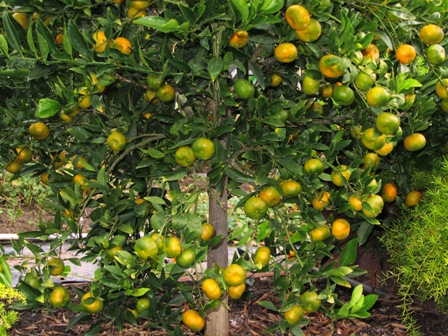
Our Satsuma mandarin orange tree prolifically bears fruit this time of year but is susceptible to freeze
Citrus trees will be covered with blankets against the frost. I’m hanging the heat lamp in my chicken house. I need to clean the chicken house, put more straw in the nesting boxes, and a ground corncob material on the floor. Already, I’ve put the windows back in (leaving a crack open for ventilation).
I opened the beehives last weekend and added an extension onto one hive–something not normally done during autumn when you typically shrink the size of your hives. The hive seemed overpopulated and the bees seemed stressed. After closing that hive, I wrapped both of them with blankets.
With the the citrus protected, the heat lamp in the chicken house, and the beehives covered, I can return to my indoor work . . . it never stops but my passion has always been to live close to the earth and write. This is the good life, made better by this wonderful Mediterranean-like climate that enable our citrus and grapes to thrive (although plunging temps make for a little extra work protecting them).
* * *
Enjoy reading about farming topics? Check out my cozy mysteries–A BEELINE TO MURDER and also THE MURDER OF A QUEEN BEE (both in the Henny Penny Farmette series from Kensington Publishing).
These novels are chocked full of recipes, farming tips, chicken and beekeeping tips, sayings and, of course, a charming cozy mystery. For more info, click on the links under the pictures.
The books are available through online retailers such as Amazon, Barnes & Noble, Kobo Books, and Walmart as well as from traditional bookstores everywhere.
See, http://tinyurl.com/hxy3s8q
This debut novel launched the Henny Penny Farmette series of mysteries and sold out its first press run. It’s now available in mass market paperback and other formats.
See, http://tinyurl.com/h4kou4g
NEWLY RELEASED! This, the second cozy mystery in the Henny Penny Farmette series, is garnering great reviews from readers and industry publications.
A Forty-foot Tall Brazilian Beauty
We recently lost the elm tree that stood about 25 feet tall next to the small house on our Henny Penny Farmette. On hot days, we really feel the heat now that the elm’s shady canopy is gone. Among the trees we are considering as a replacement for the elm is a Jacaranda mimosaefolia.
This Brazilian beauty will grow to 40 feet tall and spread from 15 to 30 feet wide. The trees begin to branch profusely when they reach about 6 feet high. I love the fernlike leaves and the 8-inch long clusters of bluish-lavender tubular flowers. The tree blooms abundantly in June and is stunning in any landscape or garden.
The trees will tolerate a wide variety of soil types. Water must be consistent but too much will create profuse tender growth and too little will stunt the tree. We purchased two of these gorgeous trees and will plant them at the front of our home, far enough away from each other to allow them to mature without crowding.
Although I will miss the elm shade until the jacarandas grow large, I won’t miss the debris of seed pods and small branches easily fractured from the elm. Mature Jacaranda’s in full bloom are a sight to behold and they’re fairly easy to grow.
* * *
If you enjoy reading about farmette topics (including gardening, beekeeping, and delicious recipes), check out my cozy mysteries A BEELINE TO MURDER and also THE MURDER OF A QUEEN BEE in the Henny Penny Farmette series (from Kensington Publishing).
Enter the Goodreads Giveaway–September 29 to October 6–for a chance to win a signed copy of a first-edition hardcover of The Murder of a Queen Bee. Three lucky winners will be chosen.
These novels are chocked full of recipes, farming tips, and sayings as well as a charming cozy mystery.
The books are available through online retailers such as Amazon, Barnes & Noble, Kobo Books, and Walmart as well as from traditional bookstores everywhere.
See, http://tinyurl.com/hxy3s8q
This debut novel launched the Henny Penny Farmette series of mysteries and sold out its first press run. It’s now available in mass market paperback and other formats.
See, http://tinyurl.com/h4kou4g
Release date is THIS WEEK–September 27. This book, the second cozy mystery in the Henny Penny Farmette series, is garnering great reviews on Goodreads.com.
It’s available free on Net Galley (netgalley.com) for readers, bloggers, and other professionals who write reviews.
What’s Not to Love about Edible Figs?
Many backyard gardeners start checking their fig trees this time of year for ripe fruit. Most figs grown for their fruit bear two crops a year (spring and fall). When figs are ripe, the globular fruit becomes soft and hangs downward from the branch. This fruit will not ripen on the windowsill or in a paper bag, so picking fruit while it is still firm is not advised.
I grow White Genoa, Adriatic, and Brown Turkey figs on my farmette. One of my nearest neighbors grows the Mission fig, which is a very large tree taking up most of his backyard. This time of year, his tree is heavily laden with purple-black fruit. Throughout the fall, that Mission fig tree is frequently visited by the birds, squirrels, and raccoons that eat the fruit.
Cooks appreciate the versatility of figs for cooking. There are many ways to prepare them. Grilled figs are delicious when served on a crostini with a dollop of goat cheese and drizzled with honey. The pulp can be used to make fig bars and other types of cookies. Luscious, juicy figs may be made into chutney or jam, baked in cakes, paired with almonds in a tart, sliced into salads, grilled with lamb, or served simply with port.
Fig trees are easy to grow, too. They need full sun and good drainage; many cultivars are drought tolerant. Lightly prune as necessary in winter. Enjoy.
* * *
If you enjoy reading about farmette topics (including gardening, beekeeping, and delicious recipes), check out my cozy mysteries A BEELINE TO MURDER and also THE MURDER OF A QUEEN BEE in the Henny Penny Farmette series (from Kensington Publishing).
These novels are available through online retailers such as Amazon, Barnes & Noble, Kobo Books, and Walmart as well as from traditional bookstores everywhere.
See, http://tinyurl.com/hxy3s8q
Now available in mass market paperback, this debut novel launched the Henny Penny Farmette series of mysteries and sold out its first press run.
See, http://tinyurl.com/h4kou4g
The second cozy mystery in the Henny Penny Farmette series, available Sept. 27, 2016, is now available on Net Galley (netgalley.com) for professionals and readers who write reviews.
Giant Sunflowers Brighten a Garden, Cornfield, or Wall
Ralph Waldo Emerson once observed, “The earth laughs in flowers.” Among the many flowers I plant around the Henny Penny Farmette each year, sunflowers are my favorites.
What’s not to love about these gorgeous beauties that inspired master artists like Van Gogh, Monet, and Gauguin as well as farmers like my grandmother who put them in fruit jars and crockery to brighten the rooms of her Missouri farmhouse?
I like to grow smaller ones at the back of a flower bed and the giant ones against walls or at the back of my patch of summer corn.

These sunflowers stand about 12 feet tall and produce several heads. Heritage varieties produce several heads.
Giant sunflowers need space to grow to full size since they will grow well over six feet. In my garden, they tower over the corn. Bees love them for their pollen. Kids love them when the foliage of the plants create a secret fort or a fairy circle. Humans, birds, and squirrels love them for their seeds.
For best results, plant giant sunflowers at the back of a garden. They need good soil and full sun. Plant when the danger of frost has past. A rule of thumb to follow is to plant them about one inch deep and six inches apart. While the seeds are germinating, keep the soil moist.
Later on, when the plants stand about three inches tall, you can thin them. Leave about one foot between each plant. This enables a strong root system for form. The stalks will become sturdy and measure about three to four inches in circumference when fully grown.
First come the gorgeous petals in green to yellow and then bright yellow. As the bees pollinate the florets and they drop, the seeds will mature. Seeds are either gray or brown in color.
I always cut the heads when the seeds are plump, firm, and begin to drop. I let the heads dry well in the sun for days before I remove the seeds. Fully dry seeds can be stored in containers for human consumption or to be fed to the squirrels and birds. Don’t forget to save some for planting in next year’s garden.
* * *
If you enjoy reading about farmette topics (including gardening, beekeeping, and delicious recipes), check out my cozy mysteries A BEELINE TO MURDER and also THE MURDER OF A QUEEN BEE in the Henny Penny Farmette series (from Kensington Publishing).
These novels are available through online retailers such as Amazon, Barnes & Noble, Kobo Books, and Walmart as well as from traditional bookstores everywhere.
See, http://tinyurl.com/hxy3s8q
Now available in mass market paperback, this debut novel launched the Henny Penny Farmette series of mysteries and sold out its first press run.
See, http://tinyurl.com/h4kou4g
The second cozy mystery in the Henny Penny Farmette series, available Sept. 27, 2016, is now available on Net Galley (netgalley.com) for professionals and readers who write reviews.
What’s Growing in the July Garden?
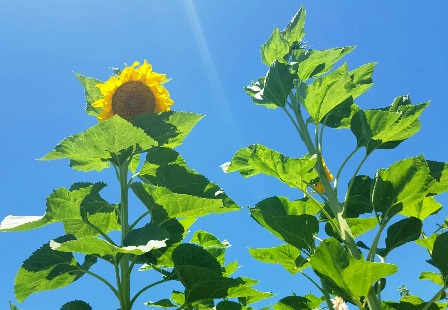
Sunflowers are native to North America and were taken to Europe in the 16th century; however, they date back to roughly 3,000 B.C. Honeybees love sunflowers.
Towering above the squash and lavender in my garden are rows of green corn stalks bearing ears of sweet, plump kernels. Snaking along the rows at the base of the cornstalks are vines laden with butternut squash and Armenian cucumber.
There are ripe tomatoes, too, especially the prolific heirloom–Red Beefsteak. I love cutting up some of these fresh, thin-skin tomatoes and combining them with basil, olive oil, grated cheese, and pine nuts as a topping for pasta. Add some grilled, seasoned chicken and you’ve got a quick and delicious summer lunch.
Zucchini and yellow squash sport large, showy blooms and are producing like crazy this month. While you can harvest and eat the blooms, we prefer the squash. Zucchini is delicious grilled or tossed with rosemary potatoes and onions or made into a French lentil and tomato salad (see recipe from last week’s posting).
Growing on vines trained over a wall and on supports, the green table grapes are beginning to swell. The taste is still a little tart, but will sweeten with the passage of another couple of weeks.
* * *
If you enjoy reading about farmette topics (including gardening, beekeeping, and delicious recipes), check out my cozy mysteries A BEELINE TO MURDER and also THE MURDER OF A QUEEN BEE in the Henny Penny Farmette series (from Kensington Publishing).
These novels are available through online retailers such as Amazon, Barnes & Noble, Kobo Books, and Walmart as well as from traditional bookstores everywhere.
Now available in mass market paperback, this debut novel launched the Henny Penny Farmette series of mysteries and sold out its first press run.
COMING SOON: The second cozy mystery in the Henny Penny Farmette series, available Sept. 29, 2016
Some Like It Hot
When it comes to growing and eating peppers, many people will opt for the sweet, mild peppers while others prefer the ones with heat. The reasons are varied but may have to do with factors such as cultural (we eat what’s in our environment or what we’ve grown up eating), genes (yes, they play a role in how we taste), and the adrenalin (some folks experience a rush) that can come from eating spicy hot cuisine.
A compound known as capsaicin is the active ingredient that provides the heat in hot chili peppers. Capsaicin is most often found in the light-colored ribbing known as pith. The seeds may contain a little capsaicin but taste hot most likely because of contact with the pith.
Capsaicin heat is measured on the Scoville Scale as Scoville Heat Units (SHU). An Anaheim chili pepper might have 500-2,500 SHU, for example, whereas a cayenne pepper might measure upwards of 30,000-50,000 SHU. Then, there are the tiny habanero peppers that can exceed 100,000 SHU. The hottest peppers in the world measure beyond 1 million SHU.
If you like it hot, try growing some heirloom peppers such as the Hungarian Yellow Wax or the tiny Scotch Bonnet, so appreciated in Caribbean cuisine.
* * *
If you enjoy reading about gardening, keeping bees, raising chickens, and creating delicious recipes, you might want to check out my novels from Kensington Publishing. The Henny Penny Farmette series of cozy mysteries are available online and in tradition bookstores everywhere, in hardcover, kindle, and mass market paperback formats.
The Murder of a Queen bee will be released September 29, 2016 in hardcover and kindle formats and can be pre-ordered. See, http://tinyurl.com/j9vh7vr
Check out my article about “How to Make a Lavender-Sage Smudging Stick.” See, http://tinyurl.com/jds38e8
 Facebook
Facebook Goodreads
Goodreads LinkedIn
LinkedIn Meera Lester
Meera Lester Twitter
Twitter




